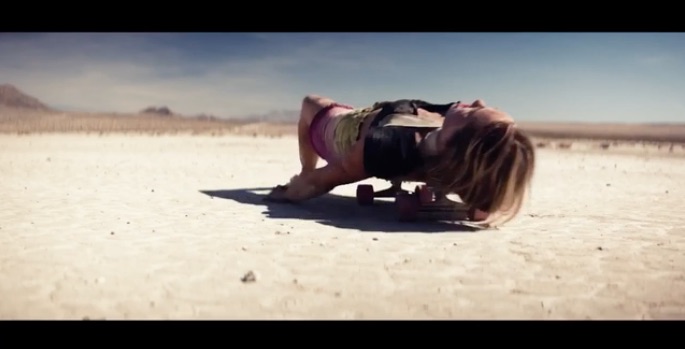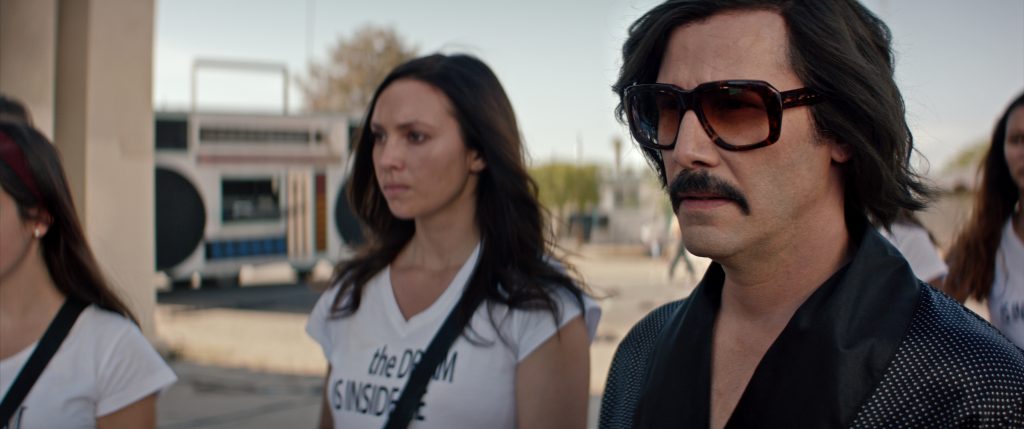For writer/director Ana Lily Amirpour, her latest screenplay, The Bad Batch, started with a single image.
“The first thing I wrote – and I didn’t know how she was going to get the skateboard – but I just had this image of a girl, missing an arm and a leg, rowing herself on a life boat in a sea of dirt in the middle of nowhere. And then I worked backwards to create the fairytale that allows that moment to exist inside of the story.”
Did Amirpour really just describe her movie about a savage group of cannibals in a lawless, post-apocalyptic desert as a fairytale? Yes, she did. But she sees fairytales in stories we may not, and that’s a good thing.
“Fairytales are the first things that seduced me as a kid. The Never Ending Story – when I saw that I thought, ‘I am Atreyu, and I’m Bastian reading the story, and I’m losing my horse in the Swamp of Sadness and the Nothingness is eating everything. Losing yourself inside of a world, that’s the magic of movies. Oh, and Terminator 2 – that’s a fairytale. It’s a big, epic action-survival movie, but to me that’s a fairytale.”

Suki rolls across the desert. Photo courtesy: Neon
Actress Suki Waterhouse, who’s sitting with us during the interview, nods in agreement. Waterhouse plays Arlen, the protagonist in the film who manages to live happily ever after despite being down one arm and leg.
When I suggest that actress Waterhouse is Amirpour’s princess in this dystopian fairytale, both she and Waterhouse laugh. “She is Alice in Wonderland,” says Amirpour, “Or maybe, Alice in Not-So-Wonderland,”
Waterhouse interjects, “She’s Alice in I’ll F&%*-You-Up-Land.” We all laugh.
Though there are some serious themes in this film, it’s clear the filmmakers don’t take themselves too seriously and that’s good when your film is about cannibals and a freaky cult leader called The Dream, played by Keanu Reeves with intense creepy charm. Jim Carrey also appears in the film as The Hermit, a prophetic loner.
Let’s look at the bare bones of fairytale structure:
- Hero leaves safe and familiar world in search of a prize
- Hero warned NOT to go to forbidden place, Hero goes anyway
- Hero meets the villain
- Hero is deceived by the villain
- Hero is attacked or tested by villain
- Hero finds prize
- Hero battles villain with inferior weaponry
- Hero outsmarts villain and collects prize
- Hero returns home having learned a universal truth
Heroine Arlen goes through all nine of these steps.
If you’ve never heard of Ana Lily Amirpour, you may have heard of her stunningly gorgeous film, A Girl Walks Home Alone at Night. Shot in stark black and white with the dialogue in Farsi, the film is commonly referred to as the first Iranian Vampire Spaghetti Western.

Keanu Reeves in The Bad Batch. Photo courtesy: Neon
Her color, English-language follow up, The Bad Batch, won the Special Jury Prize at the 2016 Venice Film Festival.
When asked about the biggest challenge to telling this kind of “extremely amplified dark fairytale,” she says, “It’s all challenging, but it’s also a joy for the reason that you get to create a universe that makes sense to you and all the problems in that universe are solvable by you. When in life do you get to feel like that? For me it’s only when I’m making a movie. There’s really no other thing in life that gives me that comfort.”
Amirpour pauses a moment and then says, “Whoa. That was a breakthrough moment.” She laughs, and adds, “I just got goose bumps and feel kind of exposed but it’s true.”
And that’s precisely our job as writers. Create worlds where we are the gods and only we can breathe life into the characters whose fate is in our hands.
After attending UCLA Film School, Amirpour made a few short films before starting a crowdfunding campaign on Indiegogo.com to make her film A Girl Walks Home Alone at Night. She raised nearly $57k and used that as her budget. I asked if making her short films helped her to break in to screenwriting.
“I don’t know if I’ve broken in. I feel like that’s one of those ideas that sounds very sexy, but there’s no breaking in. There’s just this constant shattering of a million tiny pieces of glass and you just hope the water doesn’t leak out of whatever the thing is. I don’t really know what breaking in means, I just want to keep making art that matters to me.”
The Bad Batch opens June 23.




3 Replies to "How One Writer Used Fairytale Structure for her Script about Cannibals"
jwileyd June 22, 2017 (6:21 am)
Once an editor always and editor–intriguing article but I stopped at “in seek of a prize.” Maybe it’s the gremlins of autocorrect working, but it should be “in search of a prize.” I’m also interested in using fairytale structure, and this offers possibilities I hadn’t considered before.
Jenna Milly June 22, 2017 (11:29 am)
Thanks for your comment. Great catch!
Paul June 25, 2017 (10:53 am)
Where did this “fairytale structure” rundown come from. It reads like a version of Joseph Campbells heros journey?